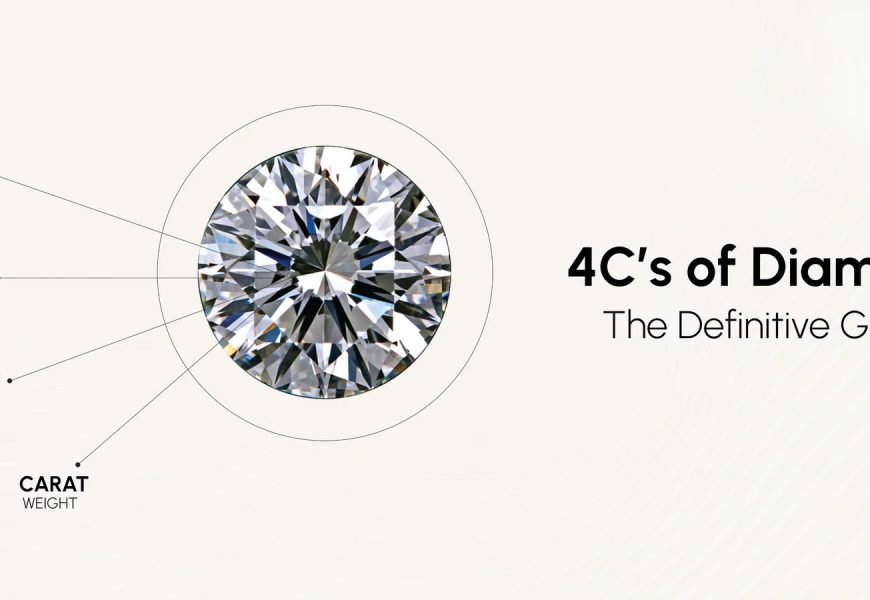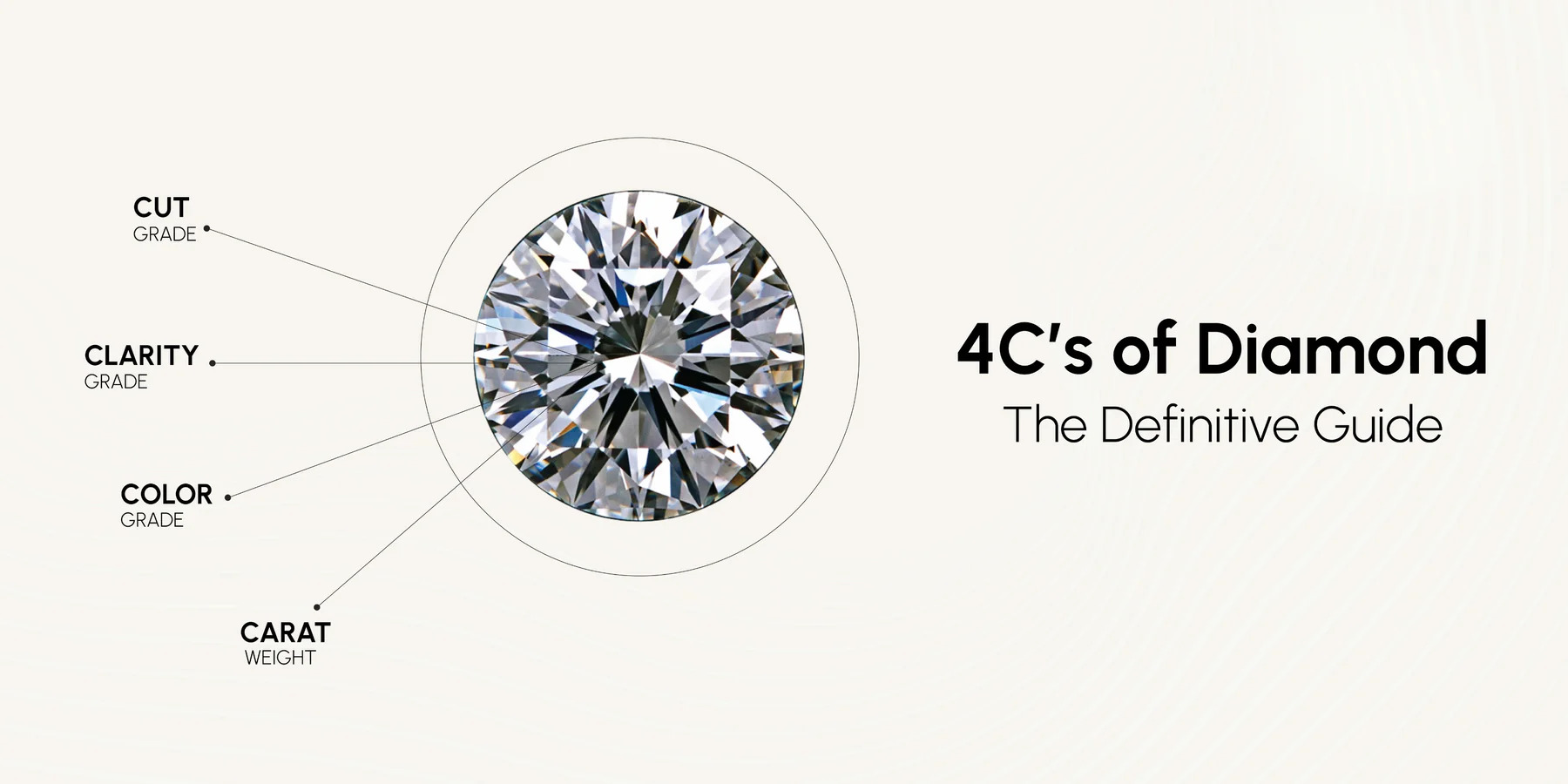When it comes to purchasing a diamond, one of the most important things you can do is understand the 4 C’s: Cut, Color, Clarity, and Carat Weight. These four factors are the universal standards used to evaluate a diamond’s quality and value. Whether you’re shopping for an engagement ring, a necklace, or any other piece of diamond jewelry, mastering the 4 C’s will help you make an informed decision and ensure that you find a diamond that’s not only stunning but also a great investment.
1. Cut: The Heart of the Diamond’s Sparkle
The cut of a diamond is arguably the most important factor when it comes to its overall appearance. While color, clarity, and carat weight play a significant role, it’s the cut that truly determines how a diamond reflects light, and consequently, how brilliant and sparkly it looks.
What Is the Cut of a Diamond?
The cut refers to how well the diamond has been shaped and faceted by a skilled jeweler. The better the cut, the more it maximizes the diamond’s ability to sparkle. A well-cut diamond will reflect light beautifully, while a poorly cut diamond may appear dull or lifeless.
Cut Grades: Diamonds are graded on cut quality, ranging from Excellent to Poor. A diamond with an excellent cut has perfect symmetry, proportions, and polish, allowing it to capture and reflect light in the best possible way. On the other hand, diamonds that are poorly cut lose light and don’t exhibit the brilliance they could have, even if they have good color and clarity.
Shapes and Effects: Diamonds come in many shapes, such as round, princess, oval, and emerald, among others. Each shape has unique proportions that affect how light interacts with the diamond. The round brilliant cut, for example, is famous for its dazzling sparkle, while other cuts like the emerald or cushion cut tend to have a softer, subtler shine.
2. Color: How White or Yellow Is Your Diamond?
The color of a diamond refers to the amount of color present in the stone. While most diamonds appear to be white, they actually contain a slight hint of color. The less color a diamond has, the more valuable it is.
The Diamond Color Scale: Diamonds are graded on a scale from D (colorless) to Z (light yellow or brown). The color grading system used by gemologists ranges from D to Z, with D being the most valuable (colorless) and Z showing noticeable traces of color.
Colorless (D-F): Diamonds in this range are completely clear, with no color noticeable even under magnification. They are the rarest and most expensive.
Near-Colorless (G-J): These diamonds have very slight color that is difficult to detect with the naked eye. They offer great value, as they appear colorless to most people.
Faint Color (K-M): These diamonds have a noticeable color, and their price drops accordingly.
Choosing the Right Color: If you’re after maximum sparkle, diamonds in the D-F range are a great option. However, if you’re on a budget, diamonds in the G-J range are also fantastic choices, offering excellent value without compromising too much on appearance.
3. Clarity: The Purity of the Diamond
Clarity refers to the presence of internal and external imperfections, known as inclusions and blemishes, respectively. These flaws can affect the diamond’s appearance, but many are microscopic and invisible to the naked eye.
What Is Clarity?
Diamonds are formed under high pressure and temperature, and during this process, small inclusions or blemishes may form. These imperfections can include air bubbles, cracks, or minerals trapped inside the diamond, and are graded based on their size, number, and visibility.
Clarity Grades: The clarity scale ranges from Flawless (FL) to Included (I). Here’s a breakdown of the most common grades:
Flawless (FL): No inclusions or blemishes visible even under 10x magnification.
Very Very Slightly Included (VVS1 and VVS2): Inclusions are difficult to detect under 10x magnification.
Very Slightly Included (VS1 and VS2): Inclusions are small but can be detected under 10x magnification. They’re still very difficult to spot with the naked eye.
Slightly Included (SI1 and SI2): Inclusions are visible under 10x magnification, but may not be noticeable without a magnifying lens.
Included (I1, I2, I3): Inclusions are visible to the naked eye and may impact the diamond’s brilliance.
Balancing Clarity and Budget: While flawless diamonds are stunning, they are rare and can be extremely expensive. Most people choose diamonds with slight inclusions, like those in the VS or SI ranges, as these imperfections are almost invisible to the naked eye.
4. Carat Weight: The Size of the Diamond
Carat weight is a measure of how much a diamond weighs, and often, it’s the most visible factor when determining the value of a diamond. However, it’s important to understand that carat weight doesn’t always determine the overall beauty of a diamond. A smaller diamond with a better cut, color, and clarity may appear more brilliant than a larger, lower-quality diamond.
Understanding Carat Weight: One carat equals 200 milligrams. The carat weight of a diamond affects its price, as larger diamonds are rarer and harder to find. However, it’s important to keep in mind that a diamond’s cut, color, and clarity also influence its overall appearance and value.
Visual Size vs. Weight: The way a diamond is cut can also affect how large it looks. For example, a well-cut diamond will appear larger and more brilliant than a poorly cut diamond of the same carat weight.
Choosing the Right Carat Weight: If you want a diamond with a larger visual impact, you may want to opt for a slightly smaller carat weight but prioritize a high-quality cut. A 1-carat diamond with an excellent cut will often look more impressive than a larger, poorly cut diamond.
Conclusion: Choosing the Right Diamond for You
Understanding the 4 C of diamond—cut, color, clarity, and carat weight—is essential when making a diamond purchase. These factors work together to determine the quality, appearance, and value of the diamond you choose. By prioritizing the aspects that matter most to you, whether it’s the sparkle of the cut or the size of the carat weight, you can find a diamond that fits your style and budget.
Remember that the perfect diamond is one that strikes a balance between all four C’s, and with a little research, you can select the diamond that will shine brightest for you.










